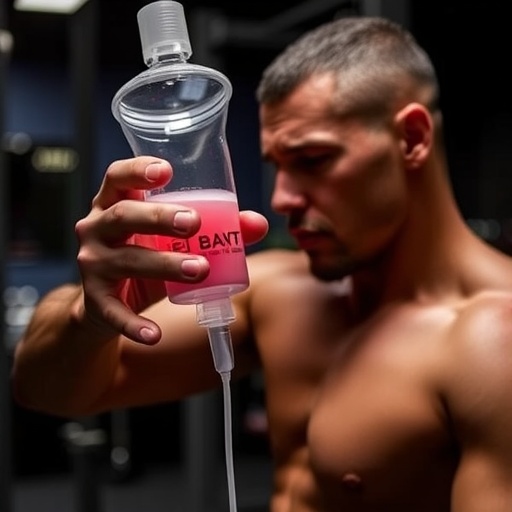Exercise has long been championed not only for its benefits to physical health but increasingly for its profound effects on brain function. Scientific advancements have affirmed what athletes and fitness enthusiasts have observed anecdotally for decades: exercise profoundly influences the brain’s biochemical environment. Enhanced blood circulation, suppression of stress-related hormones, and the stimulation of endorphins—the “feel-good” neurotransmitters—are well-documented contributors to mental well-being during physical activity. However, the molecular intricacies underlying these benefits continue to be unraveled, revealing a pivotal role for a hormone known as brain-derived neurotrophic factor (BDNF), which fosters neuronal growth, survival, and synaptic plasticity.
BDNF is produced not just by the brain but also by peripheral tissues including skeletal muscle, liver, and adipose tissue. It is instrumental in supporting neurogenesis and synaptic modulation, mechanisms critically involved in learning, memory, and overall cognitive resilience. Its production is stimulated during physical exertion, particularly under conditions of high metabolic demand. Previous research has pointed to lactate—an often-misunderstood molecule traditionally regarded as a mere waste product of anaerobic metabolism—as a potential initiator in the molecular cascade leading to BDNF expression. Lactate accumulates in the bloodstream when muscle cells metabolize carbohydrates into energy during oxygen-poor states such as intense exercise, suggesting a biochemical link between physical exertion and neurotrophic support.
A groundbreaking study published in Frontiers in Cellular Neuroscience builds on this conceptual framework by investigating whether artificially elevating blood lactate levels via intravenous infusion can simulate the neurochemical benefits of high-intensity physical exercise. This experimental approach could have profound implications for individuals unable to engage in physical activity due to medical or physical constraints. The research, conducted by Dr. Marcus Moberg and colleagues at the Swedish School of Sport and Health Sciences, reveals that lactate infusion robustly increases circulating levels of pro-BDNF, a biologically active precursor of mature BDNF, without requiring physical exertion.
The study employed a randomized crossover design involving 12 healthy adult volunteers aged 20 to 40 years. Subjects underwent two separate infusion sessions following an overnight fast: one hour of intravenous sodium lactate administration and one hour of saline solution as a control, spaced between seven and thirty days apart. Blood samples were collected at regular ten-minute intervals during infusion and up to two hours post-infusion. Additionally, skeletal muscle biopsies were taken before and after infusions to assess localized tissue responses. A control group consisting of six individuals received only saline infusions, acting as a baseline comparator to validate the observed biochemical changes.
Analyses revealed that lactate concentrations during infusion mirrored those encountered during medium to high-intensity exercise. Notably, circulating pro-BDNF levels surged within 15 minutes following lactate administration and remained elevated for at least two hours thereafter. This rise was confined to the bloodstream; neither muscle tissue pro-BDNF levels nor mature BDNF (mBDNF) in plasma or serum showed significant changes during the experimental timeframe. These findings suggest that elevated blood lactate stimulates systemic pro-BDNF release, presumably from skeletal muscle, but does not immediately convert to mature BDNF in peripheral compartments.
The divergence between pro-BDNF and mBDNF responses invites further mechanistic exploration, given that mature BDNF is the form directly implicated in neuroplasticity and synaptic modulation. One hypothesis posits that pro-BDNF serves as a reservoir, requiring enzymatic processing post-release to become functionally active. This nuance could partly explain why lactate infusion mimics only select facets of high-intensity exercise’s effects on brain health. Nonetheless, the capacity to elevate pro-BDNF pharmacologically opens intriguing avenues for therapeutic exploration, especially for populations with limited exercise capacity due to neurological or systemic illnesses.
Despite the promising biochemical signals, the study’s authors sound a note of caution against viewing lactate infusion as a substitute for physical exercise. Dr. Moberg emphasizes that the holistic benefits of exercise, encompassing cardiovascular, metabolic, and neuroendocrine systems, extend beyond the isolated hormonal influences triggered by lactate. High-intensity exercise, inducing transient but significant elevations in blood lactate, remains indispensable for optimal brain health and neurological aging. The multifactorial nature of exercise-induced neuroprotection underscores the limitation of single-factor interventions.
Looking ahead, the study illuminates pathways toward individualized exercise prescriptions tailored to optimize brain health, with lactate levels serving as a biomarker or target for intervention. Precision medicine approaches could harness this knowledge to develop pharmacological agents that modulate lactate signaling or BDNF metabolism, potentially benefiting patients vulnerable to neurodegenerative conditions or cognitive decline. However, the complexity of these molecular cascades necessitates comprehensive research to elucidate the precise regulatory mechanisms governing lactate’s influence over BDNF dynamics in humans.
Moreover, as lactate itself exerts hormone-like effects, its role transcends the classical bioenergetic context, positioning it as a critical signaling molecule within the neurometabolic axis. Future studies must explore how lactate interacts with cellular receptors, signaling pathways, and gene expression profiles to fully decode its contributions to neurotrophic factor regulation. Such efforts will be crucial to safely harness lactate’s therapeutic potential without inadvertently disrupting metabolic or neural homeostasis.
In conclusion, this pioneering experimental evidence confirms that intravenous lactate infusion can partially replicate the neurochemical environment induced by vigorous exercise, particularly by elevating circulating pro-BDNF. While this breakthrough adds a novel dimension to our understanding of exercise-induced brain benefits, it simultaneously reinforces the irreplaceable value of physical activity as a cornerstone of neurological health. Lactate-based interventions may one day complement exercise regimens or serve as adjuncts in clinical populations, but for the general population, engaging in regular high-intensity workouts remains a non-negotiable strategy for maintaining cognitive vitality.
It remains a scientific imperative to advance research aimed at translating these molecular insights into practical, scalable therapies to combat age-related cognitive decline and neurological disorders. For now, the age-old prescription to “keep moving” retains its preeminence, backed by a deeper molecular rationale that bridges metabolism, neurobiology, and systemic health in an elegant physiological symphony.
Subject of Research: People
Article Title: Lactate Infusion Increases Circulating pro-Brain-Derived Neurotrophic Factor Levels in Humans
News Publication Date: 23-Sep-2025
Web References: https://www.frontiersin.org/journals/cellular-neuroscience/articles/10.3389/fncel.2025.1644843/full
References: DOI: 10.3389/fncel.2025.1644843
Keywords: exercise, lactate infusion, brain-derived neurotrophic factor, BDNF, pro-BDNF, neuroplasticity, intravenous lactate, muscle biopsy, cognitive health, neurotrophic factors, high-intensity exercise, neurometabolism
Tags: anaerobic metabolism and exercise.benefits of physical activitybiochemical effects of exercisebrain-derived neurotrophic factorendorphins and mental well-beingexercise and brain functionhormonal release post-workoutLactate IV infusionmetabolic demand and lactateneurogenesis and cognitionneuronal growth stimulationsynaptic plasticity and learning





